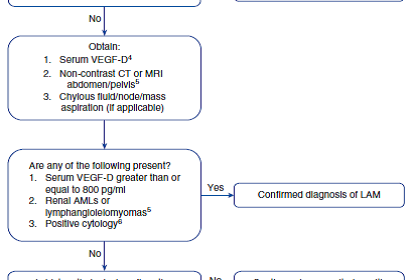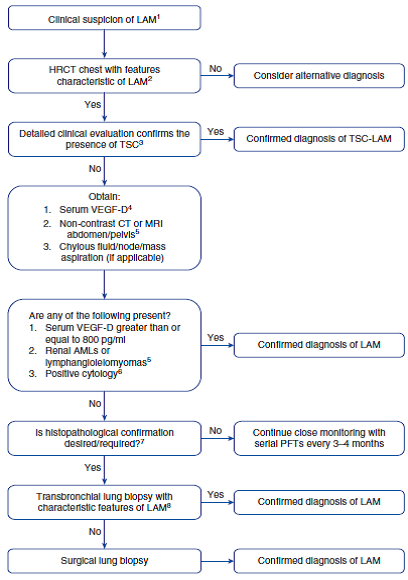
University of Cincinnati Faculty Lead Development of LAM Guidelines
“Although lymphangioleiomyomatosis [LAM] is a rare condition, many pulmonary physicians will encounter it at some point in their careers, and it is important for the community to have the tools to properly diagnose and manage the disease,” said Francis McCormack, MD, University of Cincinnati Taylor Professor and director, division of pulmonary, critical care and sleep medicine, and lead author of Part 1 of the American Thoracic Society/Japanese Respiratory Society Guidelines for the Diagnosis and Management of LAM1.

Proposed algorithm for the diagnosis of lymphangioleiomyomatosis (LAM) in a patient with compatible clinical history. The algorithm is designed as a step-wise, least-invasive approach to confirm the diagnosis of LAM. Modifications on the basis of clinical judgment are frequently required, and diagnostic decisions must be individualized. AML = angiomyolipoma; CT = computed tomography; DLCO = diffusion capacity of the lung for carbon monoxide; HRCT = highresolution computed tomography; MRI = magnetic resonance imaging; mTOR = mechanistic target of rapamycin; PFTs = pulmonary function tests; TSC = tuberous sclerosis complex; VEGF-D = vascular endothelial growth factor-D.
Although medical treatment diagnoses and guidelines are in place for LAM patients, four new questions are addressed in Part 2 of the Guidelines published November 15, 2017, with Nishant Gupta, MD, assistant professor of medicine, and director of the University of Cincinnati (UC) Medical Center interstitial lung diseases center, divisions of pulmonary critical care and sleep medicine, as the first author2. Dr. McCormack was the founding scientific director of the LAM Foundation, which also supported the Guidelines, and has been associated with the organization for over 20 years.

Definition of abbreviations: D2-40 = podoplanin; HMB-45 = human melanoma black-45; HRCT = high-resolution computed tomography; LAM = lymphangioleiomyomatosis; mTOR = mechanistic target of rapamycin; TSC = tuberous sclerosis complex; VEGF-D = vascular endothelial growth factor-D; VEGFR3 = vascular endothelial growth factor receptor 3. The diagnosis of LAM should be established using the least invasive approach (details in Figure 1). In some cases, such as asymptomatic patients with mild cystic change on HRCT, a probable diagnosis of LAM with serial monitoring may be sufficient, if a definite diagnosis will not change management and some level of diagnostic uncertainty is acceptable to the patient and clinician. Every effort must be made to establish a definite diagnosis of LAM before initiation of pharmacological therapy with mTOR inhibitors. *Compatible clinical history with LAM includes young to middle-aged female patients presenting with worsening dyspnea and/or pneumothorax/chylothorax and the absence of features suggestive of other cystic lung diseases. Typical clues to an alternative etiology of cystic lung disease on history include the presence of sicca symptoms or an underlying diagnosis of connective tissue disease, significant smoking history, personal/family history of non–TSC-related facial skin lesions, and/or kidney tumors. Most patients with LAM will have an obstructive defect on pulmonary function tests. Some patients, especially early in their disease course, may be asymptomatic and have normal pulmonary function tests. †Characteristic HRCT chest features of LAM include the presence of multiple, bilateral, uniform, round, thin-walled cysts present in a diffuse distribution, often with normal-appearing intervening lung parenchyma. ‡Detailed history and physical examination to investigate for the presence of TSC is needed. The diagnosis of TSC is established based on the proposed criteria in the TSC Guidelines (65). Referral to a TSC specialist may be needed if unsure of the diagnosis. xAngiomyolipoma may be diagnosed on the basis of radiographic appearance of characteristic fat-containing lesions either on computed tomography scan or magnetic resonance imaging. Contrast is not typically required unless the vascular characteristics of the tumor need to be analyzed, such as for evaluation of the potential for hemorrhage or the planning for embolization. Similarly, lymphangioleiomyomas can typically be diagnosed on the basis of characteristic radiographic appearance. jjLAM cell cluster refers to a spherical aggregate of LAM cells enveloped by a layer of lymphatic endothelial cells that is found in chylous effusions of patients with LAM. The diagnosis of LAM can be based on typical morphological appearance of LAM cells and positive staining for smooth muscle cell markers and HMB-45 by immunohistochemistry. Lymphatic endothelial cells surrounding the LAM cells can be highlighted by positive immunohistochemical staining for lymphatic endothelial cell markers, including D2-40 and VEGFR-3.
Dr. McCormack and Dr. Gupta summarize the most significant 2016 medical treatment recommendations:
• LAM patients who experience abnormal/declining lung function should take sirolimus rather than undergo observation only;
• LAM patients with problematic chylous effusions should have sirolimus treatment before invasive management;
• LAM patients whose computed tomography (CT) scans show cystic abnormalities suggestive of LAM but no other confirmatory clinical or extrapulmonary radiologic features of LAM should have serum vascular endothelial growth factor D (VEGF-D) testing in order to establish a firm diagnosis of LAM before undergoing a diagnostic lung biopsy and;
• Doxycycline and hormonal therapy are not recommended for treatment of patients with LAM.
The four additional 2017 recommendations regarding LAM diagnosis and treatment include the following:
1. Patients who have cystic changes on high-resolution chest CT scan that are characteristic of LAM, but who have no additional confirmatory clinical, radiologic, or serologic features of LAM should NOT rely only on HRCT features for a clinical diagnosis of LAM. “This is especially important when long term treatment with mTOR inhibitors is under consideration,” said Dr. McCormack.
2. Patients who have parenchymal cysts on HRCT that are characteristic of LAM but who have no additional confirmatory clinical, radiologic, or serologic features of LAM should follow a diagnostic approach that includes transbronchial lung biopsy (tbbx) prior to a surgical lung biopsy. Dr. McCormack adds that the diagnosis of LAM is often made by tbbx in China, and recent studies from Japan strongly support the efficacy and safety of this approach. According to Dr. Gupta, “The general idea is to make an accurate diagnosis of LAM using the least invasive approach possible.”
3. Patients with LAM should be offered ipsilateral pleurodesis after an initial pneumothorax rather than waiting for a recurrent pneumothorax before undergoing a pleural symphysis procedure and;
4. Previous unilateral or bilateral pleural procedures (ie, pleurodesis or pleurectomy) should NOT be considered a contraindication to lung transplantation in patients with LAM. According to Dr. Gupta, “The bottom line is that pleural disease should be managed early, and when necessary, aggressively without undue concern about whether the interventions will preclude subsequent lung transplantation,” said Gupta.
The Guidelines are a living document, and will be updated and modified as diagnostic and management approaches in LAM evolve, said McCormack. “Our hope is that these tools will facilitate proper management and improve outcomes for all patients with LAM.”
Images reprinted with permission of the American Thoracic Society. Copyright © 2017 American Thoracic Society. Gupta, et al./2017/Lymphangioleiomyomatosis Diagnosis and Management: High-Resolution Chest Computed Tomography, Transbronchial Lung Biopsy, and Pleural Disease Management An Official American Thoracic Society/Japanese Respiratory Society Clinical Practice Guideline/Am J Respir Crit Care Med/Vol 196/pp 1337–1348. The American Journal of Respiratory and Critical Care Medicine is an official journal of the American Thoracic Society.
References
1. McCormack FX, Gupta N, Finlay GR, et al; on behalf of the ATS/JRS Committee on Lymphangioleiomyomatosis. Official American Thoracic Society/Japanese Respiratory Society Clinical Practice Guidelines: Lymphangioleiomyomatosis Diagnosis and Management. Am J Respir Crit Care Med. 2016;194(6):748-761.
2. Gupta N, Finlay GA, Kotloff RM, et al., for the ATS Committee on lymphangioleiomyomatosis. Lymphangioleiomyomatosis diagnosis and management: Official American Thoracic Society and Japanese Respiratory Society Clinical Practice Guidelines. High-resolution chest CT, transbronchial lung biopsy, and pleural disease. Am J Respir Crit Care Med. In press.
 Francis McCormack, MD
Francis McCormack, MD
Taylor Professor and Director, Division of Pulmonary, Critical Care & Sleep Medicine
Professor of Medicine
PHONE: 513-484-5697
EMAIL: frank.mccormack@uc.edu
Connect with Dr. McCormack on Doximity
Nishant Gupta, MD
Assistant Professor of Medicine
Director – Interstitial Lung Diseases Center, Division of Pulmonary Critical Care and Sleep Medicine
University of Cincinnati Medical Center
PHONE: 513-558-4831
EMAIL: guptans@ucmail.uc.edu
Connect with Dr. Gupta on Doximity
Leave a reply →
